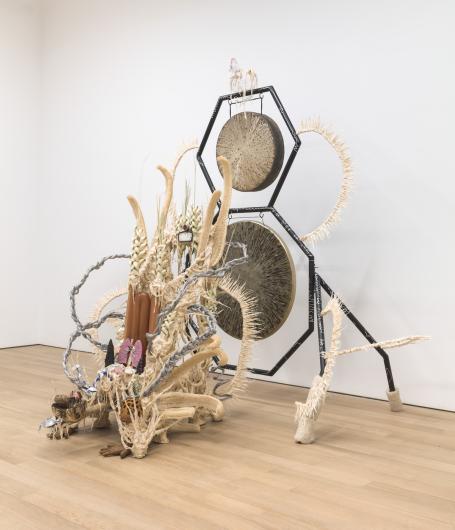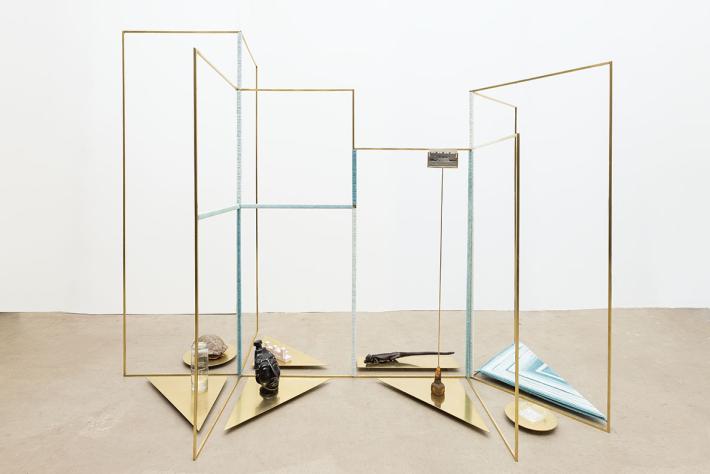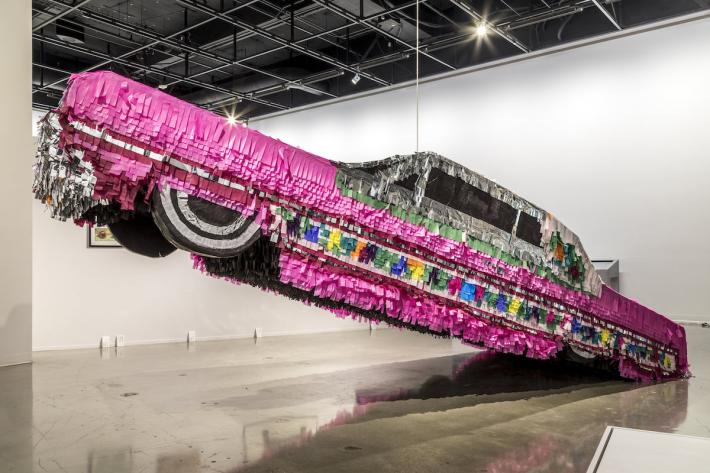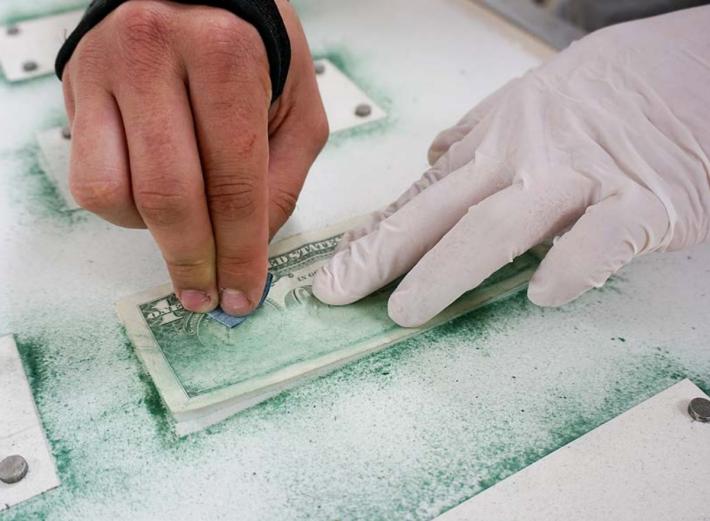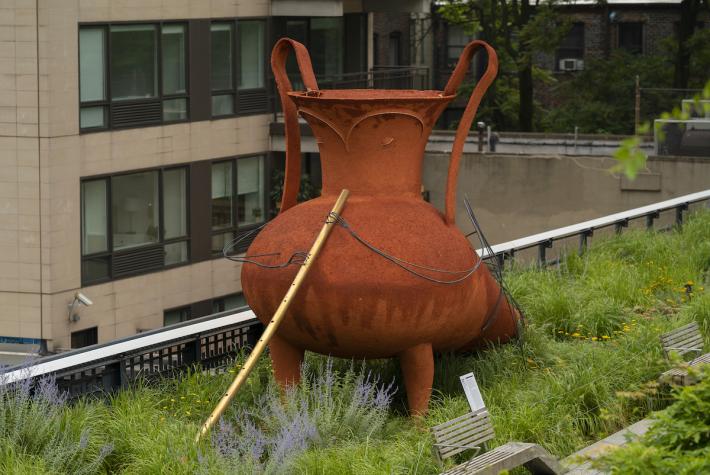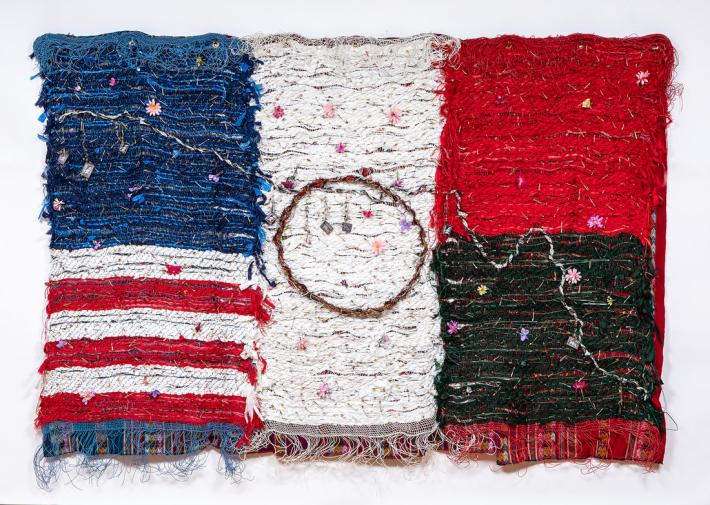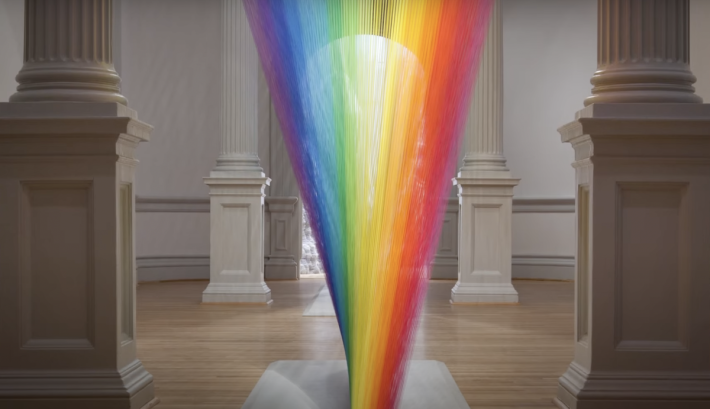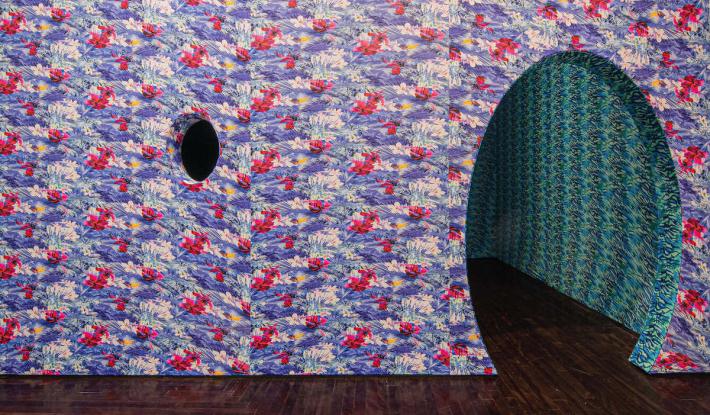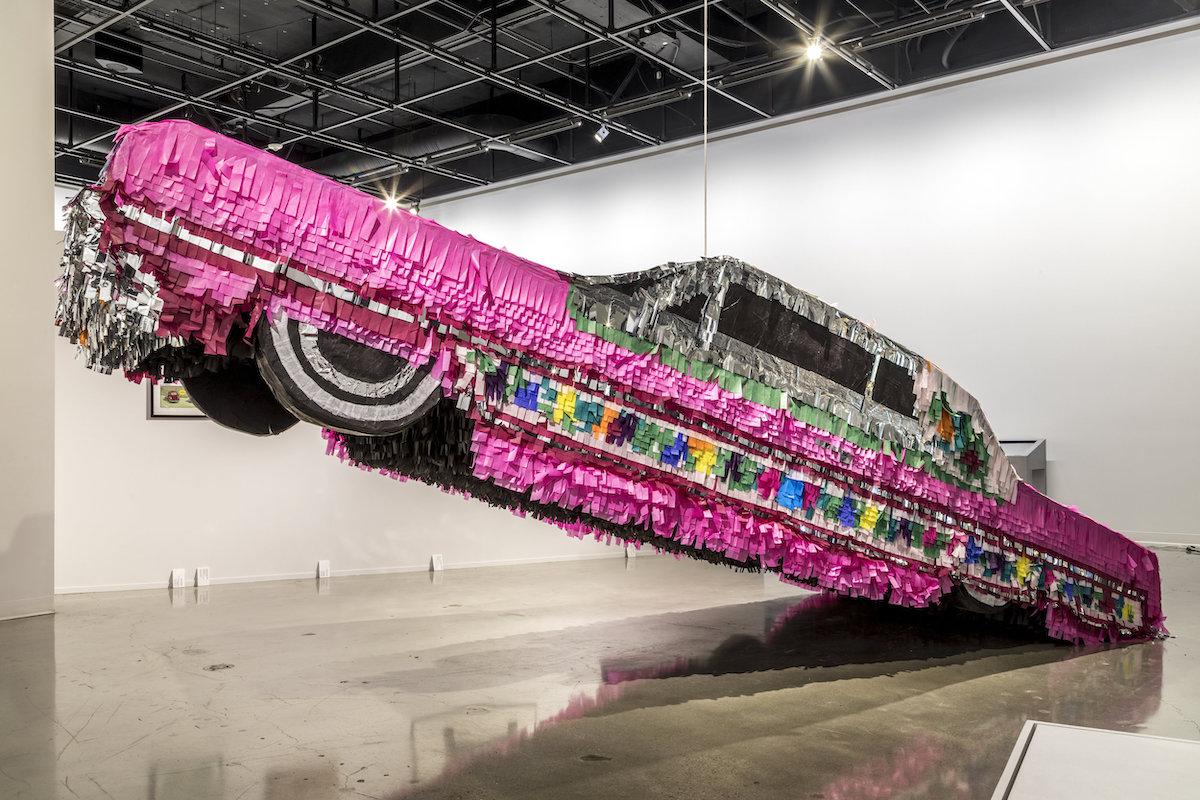
Justin Favela, Gypsy Rose Piñata, 2017
These contemporary Latinx artists have made vital contributions to the art world. From the thought-provoking textile and light installations of Gabriel Dawe to the explorations of power structures of Agustina Woodgate, and the re-examinations of ancient imagery of Claudia Peña Salinas, these eight artists have impacted how we see our communities, our culture, and the natural world.
Salvadoran-American Guadalupe Maravilla (1976) is a transdisciplinary artist who uses his art as a tool for healing. His assemblages, drawings, sculptures and performance pieces—inspired by pre-colonial Central American imagery and personal mythology—address the trauma caused by immigration, displacement, disease and war. An immigrant who escaped El Salvador’s brutal civil war as a child, Maravilla discovered the healing powers of sound as a cancer survivor, and integrates sound baths into his exhibitions. His traveling exhibition, Mariposa Relámpago, or Lightning Butterfly, is currently on view at Ballroom Marfa, in Marfa, Texas, through March 2024.
Image: Guadalupe Maravilla, Disease Thrower - Purring Monster with a Mirror on Its Back, 2022. Gong, steel, wood, cotton, glue mixture, plastic, loofah, and objects collected from a ritual of retracing the artist's original migration route. 119 x 105 x 95 ins. 302.3 x 266.7 x 241.3 cm
Inspired by pre-Columbian archaeological sites, cultural mythology and architecture, Mexican-American artist Claudia Peña Salinas (b. 1975) uses sculpture, video, and installation to create spaces that reframe and re-examine ancient imagery within a modern visual context, using modular cubes and vibrantly colored geometric forms.
Image: Claudia Peña Salinas, Hotel Palenque-Chicago's Worlds Fair, 2023. Brass, dyed ceramic, wood and shell found objects and thread, postcard. 72 x 96 x 48 inches. Collection Museum of Contemporary Art Chicago, Purchased with funds provided by Mellon Foundation, 2023.
Guatemala-Mexican-American mixed media artist Justin Favela (1986) is best known for his large-scale sculptures and installations that explore the intersection of American pop culture and the Latinx experience using piñata-cut tissue paper. Drawing on imagery from historical Mexican landscape painters, pop culture, and the Las Vegas countryside (he's based in Las Vegas), Favela builds brightly colored, multi-layered phantasmagorical landscapes. Favela is also the co-creator of the popular podcast, Latinos Who Lunch, with art historian and curator Dr. Emmanuel Ortega. His installation at "Estamos Bien—La Trienal 20/21" at the Museo del Barrio was one of the seven artworks acquired by the museum after the exhibition. He has since been in many solo and group exhibiitons including Body of Us, at Weil Gallery at Texas A&M, Corpus Christi, TX, and Fantasia/Fantasy, at Nuwu Art Gallery, Las Vegas, NV.
Image: Justin Favela, Gypsy Rose Piñata, 2017. Found objects including cardboard, styrofoam, and glue.
Argentinian artist Agustina Woodgate (1981) created a moment at Frieze New York in 2021 when she installed an ATM that sold art, doing away with the dealer for her work Don't Trust. Verify. With this an other works, she examines the infrastructures and power structures running through our society, creating stunning and provocative indoor and outdoor installations. Fascinated with giving formerly private objects new life, she reconfigures and reconstructs mass-manufactured consumer products such as maps, clocks, and toys, transforming thrifted family ephemera, such as beloved stuffed animals, into public art.
Image: Augustina Woodgate, Don't Trust. Verify, 2021. At Frieze New York.
Tucumán-born artist Gabriel Chaile (1985) paints, sculpts and creates large installations influenced by pre-Columbian art. With sleek modernistic lines his sculptural earthenware vessels and metal pots are infused with eccentric humor, a sense of community and reverence.
Image: Gabriel Chaile, El viento sopla donde quiere (The Wind Blows Where It Wishes), 2023. Adobe and mixed metal 303 x 173 x 109 in (770 x 439 x 277 cm).
Mexican-Indigenous-American fiber artist Consuelo Jimenez Underwood (b. 1949) was born into a family of farm workers, and came to social justice at an early age. Underwood uses bordered edges, barbed wire, caution sign imagery, religious iconography, and embroidered flowers to address the human suffering and ecological damage caused by unfair immigration laws and border walls.
Image: Consuelo Jimenez Underwood, Home of the Brave, 2013. Wire, silk, fabric, safety pins, synthetic and natural threads. 72" x 99". Collection of the Crystal Bridges Museum of Art
Challenging gendered ideas about the fabric arts, Mexico City-born, Dallas-based artist Gabriel Dawe (1973) explores the connection between fashion and architecture, and is fascinated with the optics of light refraction. His site specific textile installations use fine thread to create what appear to be sheets of rainbow light. He also builds fantastical jig-saw puzzle art pieces–some of which are reminiscent of architectural forms or clockwork gears.
Image: Gabriel Dawe, Plexus A1 + site specific installation at the Smithsonian American Art Museum's Renwick Gallery + Thread, painted wood and hooks + 25' x 12' x 40' + 2015. Image via Youtube.
Multidisciplinary Dominican-American artist Joiri Minaya (1990) subverts and reframes common ideas about identity. Her figurative work undermines the exotification and sexual fetishizing of Caribbean women, while her installations and performances use tropical print spandex fabric wrapped around or hung in architectural spaces, or worn as a cape or bodysuit which blends in with the environment, to create new relationships with space. The spandex installations often feature objects and artworks they are in dialogue with such as collages, video, or books. She graduated with a BFA from Parsons The New School for Design in 2013, and has has had solo exhibitions at the Kemper Museum (2020) and the Blanton Museum (2019).
Image: Joiri Minaya, Spandex installation #5 (Labadee at the Blanton Museum) 2019 Fabric, wood 18 x 24 x 16 ft
Megan D Robinson
Megan D Robinson writes for Art & Object and the Iowa Source.




